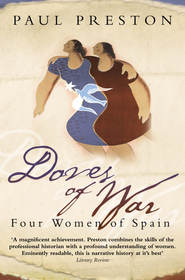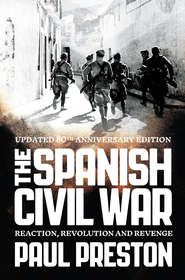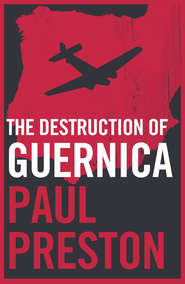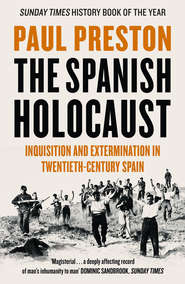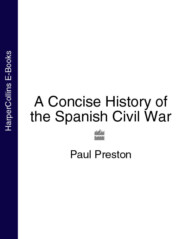По всем вопросам обращайтесь на: info@litportal.ru
(©) 2003-2024.
✖
Juan Carlos: Steering Spain from Dictatorship to Democracy
Настройки чтения
Размер шрифта
Высота строк
Поля
Given that neither Don Juan nor Juan Carlos responded to Don Jaime’s demand, on 16 January 1957, he took the matter further and gave his secretary the following letter:
‘Reuil-Malmaison 16–1–1957.
Dear Ramón,
Several friends have recently confirmed that it was my nephew Juan Carlos who accidentally killed his brother Alfonso. This confirms something of which I have been certain ever since my brother Juan failed to sue those who had spoken publicly of this terrible situation. It obliges me to ask that you request in my name, when you feel that the time is right, that the appropriate national or international courts undertake a judicial enquiry in order to clarify officially the circumstances of the death of my nephew Alfonso (RIP). I demand that this judicial enquiry take place because it is my duty as Head of the House of Borbón, and because I cannot accept that someone who is incapable of accepting his own responsibilities should aspire to the throne of Spain. With a warm embrace.
Jaime de Borbón.’
(#litres_trial_promo)
There is no evidence to suggest that Alderete acted on the letter or, if he did, that a court showed an interest in the case. Nevertheless, the combination of insensitivity and ambition demonstrated by Don Jaime was breathtaking.
The Madrid authorities were shaken by the news of the accident. Rumours started to circulate in the capital to the effect that Juan Carlos had been so overcome by grief that he was thinking of renouncing his rights to the throne and joining a friary as penance. In fact, as his father had ordered, Juan Carlos was back in Zaragoza within 48 hours of the accident. Franco’s relative silence on this issue was eloquent. Commenting on the tragedy to one of Don Juan’s supporters, he said with a total lack of sympathy ‘people do not like princes who are out of luck’. It was a recurrent theme. Two years later, he explained why he did not favour press references to Alfonsito: )‘The memory could cast shadows over his brother for the accident and make simple folk dwell on the bad luck of the family when people like their Princes to have lucky stars.’
(#litres_trial_promo) Perhaps most cruelly of all, within a year of the accident, Franco had permitted the Ministry of Education to sanction the publication and use in secondary schools of a textbook entitled La moral católica (Catholic Morality) which used the incident to explore the limits of personal culpability.
(#litres_trial_promo) Years later, Don Juan himself related that, when they met in 1960, Franco had justified keeping him off the throne by saying that the Borbón family was doomed: ‘Just look at yourself, Your Highness: two haemophiliac brothers; another deaf and dumb; one daughter blind; one son shot dead. Such an accumulation of disasters in a single family is not something that could possibly appeal to the Spanish people.’
(#litres_trial_promo)
Franco’s lack of sympathy was a reflection of his hostility to Don Juan, of his own lack of humanity and perhaps too of the fact that, in March 1956, he was cooling on the idea of a monarchist succession. The scale of Falangist discontent that had been evident since the meeting at Las Cabezas seems to have led to him mulling over the mutual dependence between Caudillo and single party. This was manifested in the cabinet reshuffle of 16 February 1956. The liberal Christian Democrat Minister of Education, Joaquín Ruiz Giménez, was dropped, a punishment for his failure to control unrest in the universities. He was replaced by a conservative Falangist academic, Jesús Rubio García-Mina. Raimundo Fernández Cuesta, the Secretary-General of the Movimiento, was also removed for his failure to control Falangist indiscipline. He had been engaged in preparations to tighten up the Francoist laws lest any future king try to free himself from the ideals of the Movimiento. He was replaced by the sycophantic Falangist zealot, José Luis de Arrese. Alarmingly, for both Don Juan and for those who were looking forward to the eventual creation of a Francoist monarchy, the Caudillo commissioned Arrese to take over the programme of constitutional preparations for the post-Franco future.
(#litres_trial_promo)
Arrese took his commission to be the preparation of an entirely Falangist future for the regime – one that would have no room for Don Juan nor even for Juan Carlos. The enthusiasm with which he went about his ambitious task would soon provoke a significant polarization of the Francoist coalition. Franco’s cabinet changes were ill-considered reactions to a deep-rooted split at the heart of his coalition. The Ley de Sucesión had been a cunning way of neutralizing regime monarchists and outmanoeuvring Don Juan. However, the prospect of a future monarchy, even a Francoist one, alienated the Falange. And Franco had few options but to cling to the Falange. If the Falange were weakened, the Caudillo’s fate would lie less in his own hands than in those of the senior Army officers who wanted an earlier rather than a later restoration of the monarchy. The situation required a complex balancing act and Arrese was more human cannonball than tightrope walker. The violent protests of Falangist students in February 1956 had been a symptom of a long death agony rather than of youthful vitality. With his mind elsewhere, occupied by the inexorable rise of Moroccan nationalism, and thus underestimating the seriousness of the crisis, Franco had responded instinctively by reasserting Falangist pre-eminence within his coalition. He was not controlling events but letting himself be driven by them.
(#litres_trial_promo)
Some months earlier, prominent Falangists had presented Franco with a memorandum demanding the swift implementation of their ‘unfinished revolution’. It was effectively a blueprint for a more totalitarian one-party State structure with no place for the monarchy of Don Juan.
(#litres_trial_promo) Franco now seemed to be giving the green light for his new Secretary-General to implement the memorandum’s recommendations. Arrese’s plans were seen by Traditionalists, monarchists and Catholics as a totalitarian scheme which would block even limited pluralism under a restored monarchy.
(#litres_trial_promo)
With the help of Rafael Calvo Serer, the Conde de Ruiseñada, at the time Don Juan’s representative in Spain, elaborated a scheme to block Arrese’s plans by hastening the restoration of the monarchy. Ruiseñada was equally devoted to both Don Juan and to Franco. For some time, he had been in contact with General Juan Bautista Sánchez, the Captain-General of Barcelona, an austere and eminently decent man who was appalled at what he saw as the corruption of the regime. Now, the so-called ‘Operación Ruiseñada’ envisaged a bloodless, negotiated pronunciamiento, rather like that of General Miguel Primo de Rivera in 1923. The lead would be taken by the Barcelona garrison, with the agreement of the other Captains-General, and Franco would be persuaded to withdraw from active politics to the decorative position of ‘regent’. While the restoration of the monarchy was implemented, day-to-day running of the government would be assumed by Bautista Sánchez. The involvement of Bautista Sánchez – the most respected professional in the Armed Forces – helped secure the support of other monarchist generals against Arrese. Don Juan had considerable doubts as to whether this wildly optimistic scheme had any hopes of success but, concerned by Arrese’s plans, agreed to let it go ahead.
(#litres_trial_promo)
Needless to say, Franco’s intelligence services, which bugged most of Don Juan’s telephone conversations with Spain, were aware of what was being plotted. It was thus all the easier for Arrese, on a tour of the south with the Caudillo, to persuade him that a Falangist future rather than a monarchist one would be truer to his legacy. Franco gave vent to his impatience with Ruiseñada and Don Juan in speeches to which he gave, according to a delighted Arrese, ‘a twist of superfalangism and aggression that seemed to many to be announcing the beginning of the final triumphant era’. In Huelva on 25 April 1956, the Caudillo delighted his audience with an unmistakable and insulting reference to the monarchists and to Juan Carlos. He declared that: ‘We take no notice of the clumsy plotting of several dozen political intriguers nor their kids. Because if they got in the way of the fulfilment of our historic destiny, if anything got in our way, just as we did in our Crusade, we would unleash the flood of blueshirts and red berets which would crush them.’
(#litres_trial_promo) At a huge meeting of Falangists in Seville on 1 May, he passionately denounced the enemies of the Falangist revolution. In a passage of his speech that seemed to be directed at Don Juan personally, he referred openly to his own near-monarchical status. Describing the Movimiento with himself at the pinnacle, he said: ‘We are a monarchy without royalty, but a monarchy all the same.’ Stating that national life had to be based on the ideals of the Falange, he declared that: ‘the Falange can live without the monarchy but what could not survive is a monarchy without the Falange.’
(#litres_trial_promo) Many Francoists were happy enough to go along with the Movimiento as long as it remained a vague umbrella institution, but defining it so closely to Falangist terms led many to re-evaluate their own preferences.
One of them, the Minister of Justice, the Traditionalist Antonio Iturmendi, was sufficiently alarmed to commission one of his brightest collaborators to produce a critical analysis of Arrese’s preliminary sketches for constitutional change. It was a decision that would have considerable impact on the later trajectory of Juan Carlos. The man given the job was the Catalan monarchist and professor of administrative law, Laureano López Rodó. His report was to be a blueprint of his growing commitment to the cause of Juan Carlos.
(#litres_trial_promo) The deeply religious and austere López Rodó, who would quickly rise to a discreet but considerable eminence, was a typical senior member of Opus Dei, quietly confident, hard-working and efficient.
More immediately significant, at the beginning of July 1956, General Antonio Barroso Sánchez-Guerra protested to the Caudillo about Arrese’s activities. He was just about to replace Franco’s cousin Pacón as head of the Caudillo’s military household. Along with two other monarchist generals, one of whom may well have been Bautista Sánchez, he discussed with Franco a version of the Operación Ruiseñada, in which a military directory would take over and hold a plebiscite on the issue of monarchy or republic, in the confident expectation that such a consultation would produce support for the monarchy.
(#litres_trial_promo) While hardly likely to go along with Operación Ruiseñada, Franco was sufficiently sensitive to military opinion to begin gradually to restrain Arrese. Nonetheless, when he made a speech to the Consejo Nacional de FET y de las JONS on 17 July 1956, the 20th anniversary of the military uprising, he used notes provided by Arrese, ‘to ensure that he did not say anything, either influenced by other sectors of the Movimiento or in an effort to calm liberal and monarchist anxieties, that might put us in an embarrassing situation later on’.
(#litres_trial_promo) Essentially a long hymn of praise to his own achievements, although not without passing praise for Fascist Italy and Nazi Germany, the speech reassured Falangists that a future monarchical successor would not be allowed to use his absolute powers to bring about a transition to democracy.
(#litres_trial_promo)
Unaware that the tide was turning against him, Arrese went ahead with his plans, distributing a draft to members of the Consejo Nacional, the supreme consultative body in the Francoist firmament. Although his text recognized Franco’s absolute powers for life, it left the decision as to his royal successor at the mercy of the Consejo Nacional and the Secretary-General of the Falange. When the text was distributed, there was uproar in the Francoist establishment, and monarchists, Catholics, archbishops and generals joined together in outrage. There were protests from three cardinals, a government minister (the Conde de Vallellano, Minister of Public Works) and several generals, at what seemed to be an attempt to give the Movimiento totalitarian control over Spain and block the return of the monarchy.
(#litres_trial_promo) By early January 1957, Arrese had been obliged to dilute his text sufficiently to satisfy his military and clerical opponents.
(#litres_trial_promo)
Between the two poles of the proposal of Operación Ruiseñada for a negotiated transition to Don Juan and Arrese’s plans for a resurgent Falangism, there emerged a middle option favoured by Luis Carrero Blanco, who had recently been promoted to Admiral. To the detriment of Don Juan and the benefit of Juan Carlos, this would ultimately be adopted by Franco. It consisted of an attempt to build on the Ley de Sucesión by elaborating the legislative framework for an absolute monarchy, in order to guarantee the continuity of Francoism after the death of the Caudillo. The legal expert commissioned to produce a blueprint was Laureano López Rodó. Carrero Blanco had been immensely impressed by López Rodó’s critique of Arrese’s text. Recognizing his talent and capacity for hard work, at the end of 1956 Carrero Blanco asked him to set up a technical secretariat in the Presidencia del Gobierno (the office of the President of the Council of Ministers) to prepare plans for a major administrative reform.
(#litres_trial_promo) As Secretary-General of the Presidencia, the doggedly loyal Carrero Blanco was Franco’s political chief of staff. As Franco began to relax his grip on day-to-day politics, Carrero Blanco was gradually metamorphosing into a Prime Minister. López Rodó, in his turn, would swiftly become Carrero’s own chief of staff.
The Opus Dei was thus well placed for the future but was still hedging its bets. Just as Rafael Calvo Serer was banking on Don Juan being Franco’s eventual successor, López Rodó was working on a long-term plan for a gradual evolution towards the monarchy in the person of Prince Juan Carlos. His plans would not come to fruition for many years. For the moment, Bautista Sánchez and other partisans of Don Juan were trying to implement the Operación Ruiseñada in order to marginalize Franco and place Don Juan upon the throne. Bautista Sánchez was under constant surveillance by Franco’s intelligence services, and therefore did not attend, in December 1956, a meeting of military and civilian monarchists involved in the scheme who gathered under the cover of a hunting party at one of the estates of Ruiseñada, El Alamin near Toledo.
(#litres_trial_promo) Nevertheless, Bautista Sánchez continued to be seen by the regime as dangerous, particularly when, in mid-January 1957, another transport users’ strike broke out in Barcelona. Although not as violent as that of 1951, the coincidence of anti-regime demonstrations at the university alarmed the authorities.
(#litres_trial_promo) Bautista Sánchez was highly critical of the Civil Governor of the province, General Felipe Acedo Colunga, for the brutal force with which demonstrations of workers and students were crushed. Franco perceived this as tantamount to giving moral support to the strikers.
(#litres_trial_promo)
Madrid was buzzing with rumours and Franco quickly jumped to the conclusion that Bautista Sánchez was fostering the strike to facilitate a coup in favour of the monarchy. After his summer-time conversation with Barroso about Operación Ruiseñada, Franco was deeply suspicious of the monarchists. In fact, there was little or no chance of military action despite the wishful thinking of Ruiseñada, Sainz Rodríguez and others. However, the conversations between the royalist plotters and Don Juan’s house in Estoril were being tapped by the Caudillo’s security services, and Franco reacted to the transcripts of these optimistic fantasies as if they were fact.
(#litres_trial_promo) He sent two regiments of the Foreign Legion to Catalonia, under his own direct orders, to join in military manoeuvres being supervised by Bautista Sánchez. Franco also sent Bautista Sanchez’s friend, the Captain-General of Valencia, General Joaquín Ríos Capapé, to talk him out of his support for Operación Ruiseñada. The Minister for the Army, General Agustín Muñoz Grandes, also appeared in the course of the manoeuvres and confronted Bautista Sánchez with the news that he was being relieved of the command of Captain-General of Barcelona. On the following day, 29 January 1957, Bautista Sánchez was found dead in his room in a hotel in Puigcerdá.
(#litres_trial_promo) Wild rumours proliferated that he had been murdered – possibly even shot by another general, perhaps given a fatal injection by Falangist agents.
(#litres_trial_promo) A long-term sufferer of angina pectoris, it is more likely that Bautista Sánchez had died of a heart attack after the shock of his painful interview with Muñoz Grandes.
(#litres_trial_promo)
Meanwhile, Juan Carlos was undergoing the process of getting over the tragedy of Alfonsito’s death. He seems to have adopted a forced gaiety and, understandably for a young man of nearly 19, spent as much time as his studies permitted in the company of girls. There were many of them and he had a readiness to think himself in love. He oscillated between being infatuated with, and just being very fond of, his childhood friend, Princess María Gabriella di Savoia. Neither Franco nor Don Juan approved of the relationship, among other reasons because she was the daughter of the exiled King Umberto of Italy, who had little prospect of recovering his throne.
(#litres_trial_promo) However, in December 1956, during the Christmas holidays at Estoril, Juan Carlos met Contessa Olghina Nicolis di Robilant, an extremely beautiful Italian aristocrat and minor film actress, who was friendly with María Gabriella and her sister Pia. She was four years older than him. His infatuation was instant and, before the night was over, he had told her that he loved her. They began a sporadic affair that lasted until 1960. She found him passionate and impulsive, not at all what she expected after what she had heard about the tragedy of Alfonsito. ‘Juanito,’ she later recalled, ‘did not show any signs of the slightest complex. He wore a black tie and a little black ribbon as a sign of mourning. That was all. I asked myself if it was a lack of feeling or if his behaviour was forced. Whatever the case, it seemed a little soon to be going to parties, dancing and necking.’ After responding to his advances, she asked about his relationship with María Gabriella. He allegedly replied, ‘I don’t have much freedom of choice, try to understand. And she’s the one I prefer out of the so-called eligible ones.’
(#litres_trial_promo)
In 1988, the 47 love letters that Juan Carlos wrote to Olghina between 1956 and 1959 were published in the Italian magazine Oggi and later in the Spanish magazine Interviú. One of the letters was extraordinarily revealing both of the situation in which the 19-year-old Prince found himself and of his relative maturity and sense of dynastic responsibility. He wrote: ‘At the moment, I love you more than anyone else, but I understand, because it is my obligation, that I cannot marry you and so I have to think of someone else. The only girl that I have seen so far that attracts me physically and morally, indeed in every way, is Gabriella, and she does, a lot. I hope, or rather I think it would be wise, for the moment, not to say anything about getting serious or even having an understanding with her. But I want her to know something about how I see things, but nothing more because we are both very young.’ He repeated the message in another letter to Olghina in which he pointed out that his duties to his father and to Spain would prevent him ever marrying her.
(#litres_trial_promo)
In her memoirs and in interviews following the publication of the letters, Olghina claimed that Don Juan had done everything possible to put obstacles in the way of the relationship. As she herself realized, Don Juan’s opposition put her in the same position as Verdi’s La Traviata, the courtesan abandoned because of the needs of her suitor’s family. In view of the innumerable lovers whose names tumble through the pages of her memoirs, Don Juan’s concern was entirely comprehensible. At one point, he stopped her being invited to the coming-out celebration in Portofino for Juan Carlos’s cousin, María Teresa Marone-Cinzano. According to Olghina, this provoked a ferocious row between Don Juan and his son, who threatened not to go to the ball. Juan Carlos eventually agreed to attend, but when he left early to go to see Olghina, there was a scuffle with his father.
(#litres_trial_promo)






